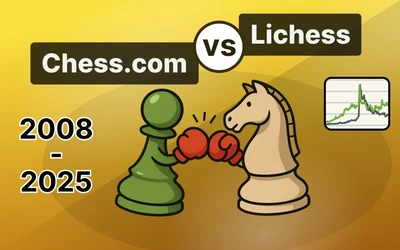
Background picture: https://pixabay.com/illustrations/wood-texture-dark-black-wall-1759566/
Beating the Jobava London (and other Nc3 lines)
Start an attack on move 4 with the Black pieces against the Jobava LondonIn the Jobava London White plays Nc3, instead of the typical Nd2. If Black isn't familiar with the opening, they can quickly blunder Nb5, where c7 is undefendable. But that's not the only idea of the Jobava London. Generally White wants to quickly castle queenside, and start an attack with Nf3-Ne5-g4.
I recommend meeting this opening with simple 3... a6. Is stops any Nb5 ideas, and prepares b5, so White can't really castle long, and attack on the kingside, as we have a faster counterattack.
And after most popular 4. e3, I've been playing 4... h6, getting a pretty easy, but uneventful game. It still is a great weapon, as it prevent's g4-g5 and initially this was the line I wanted to cover, but while writing the blog I found a different, more dynamic idea. But 4... h6 is also in the public study if you prefer a simpler line.
Let me show you my new line against the Jobava.
Jobava London with 2. Nc3
Before we get into it, I just want to state, that this is more a showcase of a line, than a reccomendation. Since I discovered it not so long ago, I don't have a lot of experience in it. However from the couple games I've played, I see it's potential, and I think it's worth sharing.
I still did my best to cover White's most popular moves, and help you understand the ideas of this line.
The move is 4... b5 starting a queenside attack. This completely prevents O-O-O ideas, and delays the tradicional c5 break.
We want to develop with e6-Bb7 (e6 first!), choose either c5-Nc6, or Bd6-Nd7, and generally go Ne4.
White has 4 ways of playing this position:
- Nf3-Ne5, a typical idea in the Jobava London, trying to start a kingside pawnstorm
- Nf3-Bd3-O-O, basically natural development, nothing crazy
- a4 at any moment, which if we prevent, or prepare for, we will have an amzing position
- And the last one a3-b4 stopping any b4 and c5 ideas for us, but destabilizing the c3 knight.
Last one is pretty rare, but a funny position can arrise, where out of the blue, without any clear inaccuracies, black can win a piece (technically, with engine defence, White doesn't lose any material, but gets a -1 position). So let's look at it first, like an appetizer.
a3-> b4
If White doesn't blunder that weird tactic where out of nowhere, White's knight is trapped, keep in mind Ne4, and develop around that. Also remember to meet Bxd6 with cxd6!, not Qxd6? The c3 knight is undefended, so you want to open the c-file, and use that to prepare e5 with Qc7.
Nf3 -> Ne5
The difference in choosing which knight to place on d7 only matters when White retreats from e4. And it's better to go for Nf6-d7, Nb8-c6 to support e5. And since you move the f6 Knight. g4-g5 is never an issue.
Quick a4
In short, if you meet a4 with b4, and follow it up with c5. And a4 is the reason, we should play 5... e6 after 5. Nf3 (to meet 6. a4 with 6... b4, and after 7. Na2, the b4 pawn is defended, so c5 is possible)
a4 played before we commit our knight to d7 isn't a great try, as it gives us the b-file and the b4 square. White is always clearly worse there
Normal development
Jobava London with 2. Nc3 summary
Just remember Ne5 isn't scary. If you have a knight on d7, you want to play Nxe4-Nd7 no matter the recapture. If you don't have Nd7 yet, it's better to play Nfd7, so if White plays like Nd3/Nf3, you can develop the b8 Knight to c6, and play for e5. Bd6-Qc7, works only if you played c4, so White can't throw in dxc5.
If White takes on c5, it doesn't matter what you recapture with that much. Just play where you are stronger - in the centre, since White lacks the d4 pawn.
If white doesn't play dxc5, go for b4-c4 and defend the c4 pawn with Na5. DONT GO c3? You want to control the d3 square, so White can't play Bd3.
Jobava London with 2. Bf4
It's not really challenging. We already have c5 on the board, so White's plan is too slow.
I like to play 2... c5 against the Accelerated London, but that does allow White to play 3. Nc3 transposing to a Jobava London with 4. e3. And we can't get the same a6-b5 thingy going on, as we are a move short. 4... a6 is still a move, but winrates show, that 4... cxd4 gives Black much better chances, transposing into the Exchange Caro, but White has a knight on c3.
4. e3
If you have ever played the Exchanged Queen's Gambit, or better yet. the Exchange Caro, you should have a very enjoyable game. Just learn the refutation of Bd3?
But 4. e3 isn't White's only option...
4. e4
White can also play the tricky 4. e4! The position is a tactical mess for a couple of moves, but if you navigate through it, you'll be fine, even enjoying a structural advantage.
You can get surprised by it one time, and that's all. There isn't a lot to learn, Black can easily equalize, and play on White's worse structure, to try and squeeze out a win. It looks tricky, but is nothing special.
Reverse Albin Countergambit
Now that I've covered the Jobava London, I want to add the rest of the Londons, where White plays Nc3, just to have them in one place.
For the cost of one pawn, White gets faster development, but the e4 pawn stops White from starting their kingside pawn storm. Most common way for White to continue is O-O-O-Bh6-Bxg7, no matter in what order.
It's a fun variation for both colors, but it's easier to play with Black, as White has to deal with the e4 pawn stopping f3-g4.
And that leaves us with the last chapter, Nc3!? in the London System
Nc3 London System
There isn't much to talk about, just remember Bg4, as White doesn't have typical Qb3. Take on d4 before playing Bd6, and enjoy your position :)
And that is all!
I'm glad to finally finish part 3, as the Jobava lines aren't very exciting compared to other ideas I descovered. Next on my radar is the Delayed London, which I found a very cool idea against. If you have no idea what I'm talking about, don't worry about it ;p
Other than this, I have interesting ideas against the Taimanov Sicilian, other Taimanov Sicilian, Four Knights Sicilian, Kan Sicilian, a few lines against the Dragon Sicilian, both 4... Nc6 and 4... e6 in Botwinnik-Carls Caro-Kann and the Nf6 Vienna. And that's only for White pieces.
For Black I have interesting lines against the Catalan, Pseudo-Catalan, Colle System, the 3 Knights English, the g3 English, the Nc3-g3 English, the King's Indian 'Attack', the Réti and the Nimzo-Larsen Attack.
If you have a keen eye, you might've noticed, that there are no lines for Black against 1. e4. That's because I don't know what to play against e4. I've been playing the Caro for quite some time now, as it offers a lot of dynamic play (in the right hands), but there are so many ways White can make the game boging, like the Breyer System, Endgame Offer, some 2 Knights lines etc. And recently I started playing the Sicilian, but there is the same problem. White can make the game boring. Against the French there is simply the Exchange Variation. I don't know what to play against e4
If you have any cool openings against 1. e4, please share them with me, because as of right now, when my opponents start with 1. e4, I'm less excited to play, than against 1. d4, 1. c4, or even 1. Nf3 (which is crazy for a tactical player like me).
Thank you for reading. It took me some time to find motivation, to study this new line against the Jobava, but also gather experience in ir. As I said before, 4... h6 is also in the study, so if 4... b5 doesn't convince you, take a look at that.
And once again, if you have interesting lines/openings/ideas against 1. e4, please share them with me, either by DM-ing me, or leaving a comment.
Love you, bye!
You may also like
 CkickyCheck
CkickyCheckPlaying My Own Novelty
I played a novelty I've found myself against a stronger opponent! CkickyCheck
CkickyCheck"Define tactical mess"
A perfect game of chess always ends in a draw... right? FM CheckRaiseMate
FM CheckRaiseMateThe 4 Lichess Studies I Make For Every Student
A setup to streamline your chess study routine ChessMonitor_Stats
ChessMonitor_StatsWhere do Grandmasters play Chess? - Lichess vs. Chess.com
This is the first large-scale analysis of Grandmaster activity across Chess.com and Lichess from 200… CM HGabor
CM HGaborHow titled players lie to you
This post is a word of warning for the average club player. As the chess world is becoming increasin… NM Chess-Network
NM Chess-Network